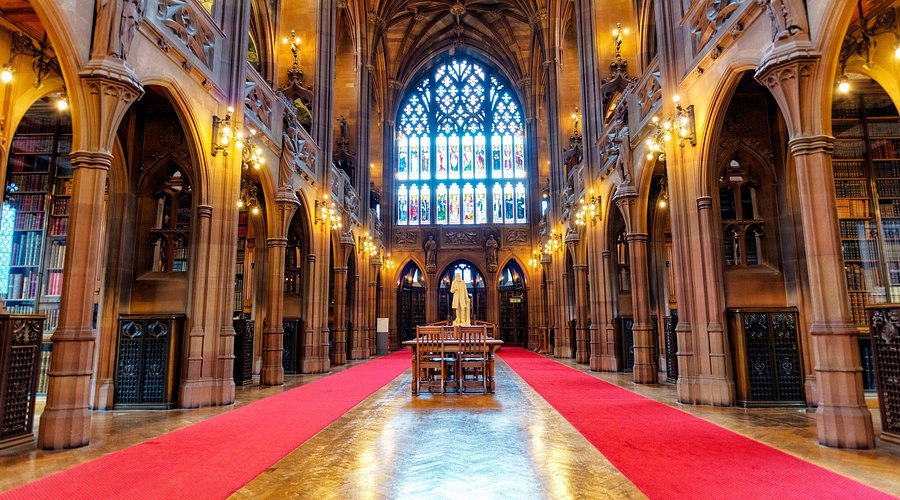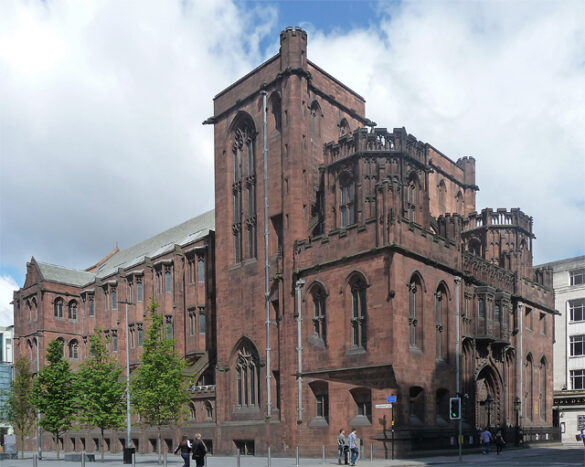The John Rylands Library in Manchester, England, stands as one of the most remarkable libraries in the world, both in terms of architectural grandeur and historical significance. Situated on Deansgate, one of Manchester’s main thoroughfares, the library is not merely a repository of books but a monument to learning, philanthropy, and the enduring value of culture in an age of rapid industrial transformation. Built at the turn of the twentieth century, the library reflects both the ambitions of Victorian Manchester and the personal devotion of Enriqueta Rylands, who commissioned it as a memorial to her husband, the industrialist John Rylands. Over time, it has developed into one of the United Kingdom’s most important research libraries, holding rare manuscripts, unique archival collections, and some of the most treasured items in the history of human thought.

Origins and Patronage
The story of the John Rylands Library begins with John Rylands himself. Born in 1801, Rylands was a pioneering textile manufacturer who played a central role in Manchester’s development as the world’s first industrial city. He built his fortune in cotton, establishing what became the largest textile manufacturing firm in the United Kingdom by the latter half of the nineteenth century. Despite his wealth, Rylands lived a relatively modest and private life, known for his religious convictions and charitable donations. He died in 1888, leaving behind not only a vast business empire but also a philanthropic legacy.
It was his widow, Enriqueta Augustina Rylands, who envisioned a lasting tribute to her husband. Deeply influenced by his devout Nonconformist faith and belief in the moral power of knowledge, she sought to create a library that would not only commemorate his life but also serve the wider public. In 1889 she purchased a plot of land on Deansgate, then a bustling area of the city, and commissioned the construction of a library that would be “for the use of the people of Manchester and of the world.” Her choice of the Gothic Revival style and the scale of her ambition reflected both her religious devotion and her desire to establish a lasting cultural institution.
Architecture and Design
The architectural design of the John Rylands Library is as striking as its collections. Enriqueta Rylands appointed the architect Basil Champneys, a figure well-known for his ecclesiastical and collegiate buildings. The result, completed in 1900, is often described as one of the finest examples of neo-Gothic architecture in Britain. Built of Cumbrian red sandstone, the library resembles a grand cathedral of learning. Its exterior is characterized by soaring towers, intricate stonework, and traceried windows, evoking the medieval tradition of scholarship while firmly asserting Manchester’s place in the cultural landscape of modern Britain.
The interior is no less impressive. Visitors enter through a series of vestibules and staircases before arriving at the main reading room, an awe-inspiring space with vaulted ceilings, stained glass windows, and statues of historical figures associated with literature, science, and religion. The atmosphere is deliberately ecclesiastical, echoing the idea that learning and reading possess a sacred quality. Light filters through richly colored stained glass, illuminating wooden bookcases and carved stonework, creating an ambience both solemn and inspiring. It is a space that was intended to elevate the mind and spirit, reminding readers that scholarship and knowledge have moral as well as intellectual dimensions.
The Collections
While the architecture is extraordinary, the library’s true significance lies in its collections. From its inception, Enriqueta Rylands set out to assemble a collection of international importance. In 1892 she made a pivotal acquisition: the private library of Lord Spencer from Althorp in Northamptonshire. Known as the Spencer Collection, it contained around 43,000 printed books, including one of the finest collections of early printed works in Britain. This purchase alone established the John Rylands Library as a major scholarly resource before it even opened its doors.
Among the treasures of the library is the Gutenberg Bible, one of fewer than fifty surviving copies of the first substantial book printed using movable type in Europe. This acquisition symbolizes the library’s mission to preserve the milestones of human learning. The Spencer Collection also included an outstanding array of fifteenth-century incunabula, fine bindings, and early editions of the classics, all of which remain central to the library’s reputation.
The library’s manuscript holdings are equally significant. Perhaps its most famous single item is the Rylands Library Papyrus P52, often referred to simply as the “Rylands Fragment.” This tiny scrap of papyrus, dating from the second century CE, is the earliest surviving fragment of the New Testament, containing a few verses from the Gospel of John. Its importance to biblical scholarship cannot be overstated, as it provides vital evidence for the early transmission of Christian texts.
Beyond the papyri and incunabula, the library houses a vast array of medieval manuscripts, archives, and printed books covering subjects from theology and philosophy to science, literature, and the arts. Over the years, it has continued to expand its holdings through donations, bequests, and acquisitions, becoming one of the leading research libraries in the world.
Role in Manchester’s Cultural Life
The establishment of the John Rylands Library must be understood within the broader context of Manchester’s transformation during the nineteenth century. As the world’s first industrial city, Manchester was a place of immense wealth and innovation but also of poverty, overcrowding, and social tension. Institutions like the library represented an effort to balance the materialism of industrial capitalism with a commitment to education, self-improvement, and civic pride.
Enriqueta Rylands intended the library to be open to all, transcending religious, social, and class boundaries. Though originally conceived as a theological library, it quickly expanded its scope to embrace human knowledge in its widest sense. For Manchester, a city whose fortunes were tied to commerce and industry, the library served as a reminder of the value of culture and learning. Its presence on Deansgate symbolized a new civic identity, one that combined economic prowess with intellectual ambition.
Merger with the University of Manchester
A significant chapter in the library’s history came in 1972, when it formally merged with the University of Manchester Library. This move was designed to consolidate resources, improve access for researchers, and secure the long-term future of the collections. While the Deansgate building remained a public-facing institution, the merger allowed for closer integration with the university’s scholarly community. Today, the John Rylands Research Institute continues this mission, fostering academic research and making the library’s collections available to scholars from around the globe.
Modern Renovations and Access
At the turn of the twenty-first century, the library underwent a major redevelopment project designed to preserve its historic fabric while improving facilities for visitors. Completed in 2007, the £17 million project included the construction of a new entrance wing, exhibition spaces, a café, and modern conservation facilities. The aim was to make the library more accessible and engaging for the public while safeguarding its treasures for future generations.
Today, the library welcomes thousands of visitors each year, including tourists, students, academics, and local residents. It hosts exhibitions, public lectures, and educational programs, ensuring that it continues to function not just as a research center but as a vibrant cultural hub in the heart of Manchester.
Symbolism and Legacy
The John Rylands Library embodies many of the ideals of its age. It represents the Victorian conviction that knowledge was both a private good and a public duty. It reflects the philanthropic spirit of industrial Manchester, where wealthy individuals sought to leave lasting cultural legacies. It also highlights the international character of scholarship, since its collections draw upon traditions from across Europe, the Middle East, and beyond.
At the same time, the library remains strikingly relevant today. In an era when digital technology is reshaping access to information, the John Rylands Library stands as a reminder of the enduring value of physical books and manuscripts. Its collections are irreplaceable artifacts of human history, each bearing unique marks of time, ownership, and use. The building itself, with its Gothic architecture, continues to inspire awe, offering a physical space where learning feels sacred.
Conclusion
The John Rylands Library is far more than a repository of books; it is a cultural landmark, an architectural masterpiece, and a monument to the transformative power of knowledge. Conceived as a memorial to John Rylands by his devoted wife Enriqueta, it has grown into one of the world’s great libraries. From the Gutenberg Bible to the Rylands Papyrus, from medieval manuscripts to modern archives, its collections chart the intellectual journey of humanity.
For the people of Manchester, it remains a source of civic pride, reflecting the city’s industrial past while pointing toward a future grounded in culture and learning. For scholars around the world, it is a treasure house of resources. And for visitors, it offers not only access to rare books and manuscripts but also an experience of beauty, awe, and inspiration. More than a century after its opening, the John Rylands Library continues to fulfill its founding vision: to be a library for Manchester, for Britain, and for the world.

